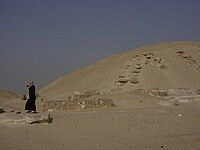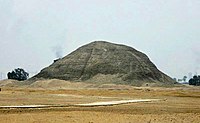Egyptian pyramids

| ||||
| Pyramid in hieroglyphs | ||||
|---|---|---|---|---|
The Pyramids of Egypt, among the largest constructions ever built, [1], constitute one of the most potent and enduring symbols of Ancient Egyptian civilization. It is generally accepted by most archaeologists that they were constructed as burial monuments associated with royal solar and stellar cults, and most were built during the Old and Middle Kingdom periods[2].

The number of pyramid structures in Egypt today is reported by most sources as being between 80 and 110, with a majority favouring the higher number. In 1842 Karl Lepsius made a list of pyramids, in which he counted 67, although more have been identified and discovered since his time. The imprecise nature of the count is related to the fact that as many smaller pyramids are in a poor state of preservation and appear as little more than mounds of rubble, they are only now being properly identified and studied by archaeologists. Most are grouped in a number of pyramid fields, the most important of which are listed geographically, from north to south, below.
Abu Rawash is the site of Egypt's most northerly pyramid other than the ruins of Lepsius pyramid number one[3]— the]], the son and successor of Khufu. Originally it was thought that this pyramid had never been completed, but the current archaeological consensus is that not only was it completed, but that it was originally about the same size as the Pyramid of Menkaure largest pyramid in Egypt.
Unfortunately its location adjacent to a major crossroads made it an easy source of stone, and quarrying — which began in Roman times — little remains apart from a few courses of stone superimposed upon the natural hillock that formed part of the pyramid's core — although a small adjacent satellite pyramid is in a better state of preservation.
Zawyet el-Aryan
This site is the location for two unfinished Old Kingdom pyramids. The northern structure's owner is believed to be the Pharaoh Nebka, whilst the southern structure is attributed to the Third Dynasty Pharaoh Khaba, (also known as Hudjefa), successor to Sekhemkhet. Khaba's four-year tenure as pharaoh more than likely explains the similar premature truncation of his step pyramid. Today it is approximately twenty metres in height; had it been completed, it would probably have more than doubled in size.
Abu Sir
There are a total of seven pyramids at this site, which served as the main royal necropolis during the fourth Dynasty. The quality of construction of the Abu Sir pyramids is inferior to those of the Fourth Dynasty — perhaps signalling a decrease in royal power or a less vibrant economy. They are smaller than their predecessors, and are built of low quality local limestone.
The three major pyramids are those of Niuserre (which is also the most intact), Neferirkare Kakai and Sahure. The site is also home to the incomplete Pyramid of Neferefre. All of the major pyramids at Abu Sir were built as step pyramids, although the largest of them — the Pyramid of Neferirkare Kakai — is believed to have originally been built as a step pyramid some seventy metres in height and then later transformed into a "true" pyramid by having its steps filled in with loose masonry.
Saqqara

Major pyramids here include the Step Pyramid of Djozer — Egypt's oldest stone monumental building — the Pyramid of Userkaf and the Pyramid of Teti. Also at Saqqara is the Pyramid of Unas, which retains a pyramid causeway that is amongst the best-preserved in Egypt. This pyramid was also the subject of one of antiquities' earliest restoration attempts, conducted under the auspices of one of the sons of Ramesses II. Saqqara is also the location of the incomplete step pyramid of Djozer's successor Sekhemkhet, known as the Buried Pyramid. Archaeologists believe that had this pyramid been completed it would have been larger than Djozer's.
Dahshur
This area is arguably the most important pyramid field in Egypt outside Giza and Saqqara, although until 1996 the site was inaccessible due to its location within a military base, and hence was virtually unknown outside archaeological circles.
The southern Pyramid of Sneferu, commonly known as the Bent Pyramid is believed to be the first (or by some accounts, second) attempt at creating a pyramid with smooth sides. In this it was only a partial — but nonetheless visually arresting — success; it remains the only Egyptian pyramid to retain a significant proportion of its original limestone casing, and serves as the best example of the luminous appearance common to all pyramids in their original state.
The northern, or Red Pyramid built at the same location by Sneferu was later successfully completed as the world's first true smooth-sided pyramid. Despite its relative obscurity, the Red Pyramid is actually the third largest pyramid in Egypt — after the pyramids of Khufu and Khafre at Giza. Also at Dahshur is the pyramid known as the Black Pyramid of Amenemhet III.
Mazghuna
Located to the south of Dahshur, this area was used in the First Intermediate Period by several kings who constructed their pyramids out of mudbrick. Today these structures are obscure and unimpressive.
Lisht

Meidum
Sneferu's Pyramid at Meidum; the central core structure remains, surrounded by a mountain of rubble from the collapsed outer casing
The pyramid at Meidum is one of three constructed during the reign of Sneferu, and is believed by some to have been commenced by that pharaoh's father and predecessor, Huni. However, this is not very likely, as his name does not appear on the site. Some archaeologists also suggest that the Meidum pyramid may have been the first unsuccessful attempt at the construction of a "true" or smooth-sided pyramid.
The pyramid suffered a catastrophic collapse in antiquity, and today only the central parts of its stepped inner core remain standing, giving it an odd tower-like appearance that is unique among Egyptian pyramids. The hill that the pyramid sits atop is not a natural landscape feature — it is in fact the small mountain of debris created when the lower courses and outer casing of the pyramid gave way.
Hawarra

Amenemhet III was the last powerful ruler of the 12th Dynasty, and the pyramid he built at Hawarra, near Faiyum, is believed to post-date the so-called "Black Pyramid" built by the same ruler at Dahshur. It is the Hawarra pyramid that is believed to have been Amenemhet's final resting place.
el-Lahun

The pyramid of Senusret II at el-Lahun is the southernmost royal-tomb pyramid structure in Egypt. Its builders reduced the amount of work necessary to construct it by ingeniously using as its foundation and core a 12 metre high natural limestone hill.
See also
Pyramids of Other Cultures
Falsely reported and alleged pyramids
- Ukrainian pyramids - Archaeological dig site falsely reported as a pyramid in 2006
- Bosnian pyramids - Also known as Visočica hill
References
- ^ The Great Pyramid of Khufu. Retrieved April 12, 2005. "The Great Pyramid of Khufu...is the largest pyramid in Egypt and was the tallest man-made structure in the World until 1888."
- ^ Michael Ritter (2003). Dating the Pyramids. Retrieved April 13, 2005. "Archaeologists have generaly believed that the magnificent pyramids at Giza were the work of the Old Kingdom Dynasty 4 in Egypt" "The astronomical records as reported precisely fixes Middle Kingdom dates. But one cannot just count back the reigns of kings into the Old Kingdom, an Intermediate period occur between the Old and Middle Kingdom."
- ^ ibid.
